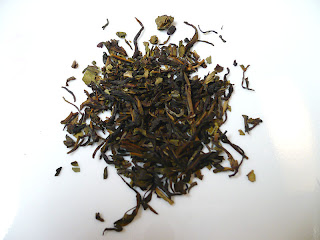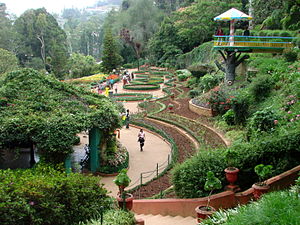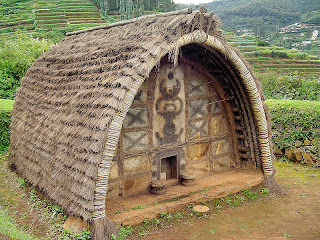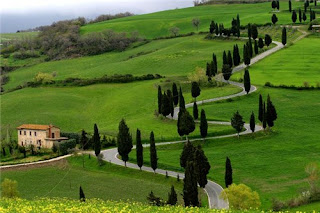Ooty Tourism |Places to visit in Ooty |Ooty pictures
About Ooty:
Ooty is a town, a municipality and the district capital of the Nilgiris district in the Indian state of Tamil Nadu.
Ootacamund is a popular hill station located in the Nilgiri Hills.Originally occupied by the Todas, the area came under the rule of the East India Company at the end of the 18th century. Today the town's economy is based on tourism and agriculture, with manufacturing of medicines and photographic film also present.
The town is connected to the rest of India by road and rail, and its historic sites and natural beauty attract tourists..
History of Ooty:
Ooty, which is deep within the Nilgiri hills, is also known as The Blue Mountains. It is unknown whether this name comes from the blue smoky haze given off by the eucalyptus trees that cover the area, or because of the kurunji flower, which blooms every twelve years giving the slopes a bluish tinge.Unlike any other region in the country, no historical proof is found to state that Ooty was a part of any kingdoms or empires. Tippu Sultan was the first to extend his border by onstructing a hideout cave like structure.
It was originally a tribal land and was occupied by the Todas along with other tribes who coexisted through specialisation and trade.Frederick price in his book Ootacamund, A History states that the area which is now called as the 'Old Ooty' was originally occupied by the Todas. The Todas then handed over that part of the town to John Sullivan, the then Governor of Coimbatore. He later developed the town,and encouraged the establishment of tea, chinchona, and teak trees. Like many of the settlers, Sullivan was highly impressed by the way the tribes cooperated, and sought to maintain this balance. He later campaigned tirelessly to ensure land rights and cultural recognition for these tribes and was financially and socially punished for this by the British Government.
spot and submitted their experience report to the Collector of Coimbatore John Sullivan. John Sullivan with his party proceeded to Nilgiri Mountain and camped at Dimbhatti, just north of Kotagiri in January 1819. Again in May 1819 he came to the Hill of Ooty and began the construction of his bungalow at Dimbhatti (near Kotagiri), the first European dwelling on the hills. John Sullivan laid the path from Sirumugai (near-Mattupalayam) to Dimbhatti in 1829 and the work was completed in May 1823. The route up to Coonoor was laid in 1830-32.Ooty served as the summer capital of the Madras Presidency and other small kingdoms, much visited by British during the colonial days, and as today, a popular summer and weekend resort. Soldiers were also sent here and to nearby Wellington (The home of the Madras regiment to this day) to recuperate. Its stunning beauty and splendid green deep valleys inspired the British to name it Queen of Hill Stations.
Ooty is visited by many tourists from around the world and was once seen on television for 'Indian Hill Railways'.
Climate of Ooty:
Winter
Max 21ºC, Min 5ºC
Summer
Max 25ºC, Min 10ºC
Rainfall
121 cms.
Ooty Weather:
The climate in Ooty is so good the British originally made it a holiday retreat more than 200 years ago. Even today, many British residents,captivated by the combination of scenery and weather in Ooty, remain. Ooty weather rarely experiences extremely trying conditions. In the winter (October-February), the temperatures generally venture no lower than 0°C-5°C and range as high as 21°C. In the summer
(March-September), the maximum daytime temperature is about 25°C. The monsoon season (July-September) brings such heavy rains that trekking is generally impossible. The trade-off, however, is fabulous lush greenery.
Economy of Ooty:
Contrary to the thought that much of the local economy is now dominated by tourism, Ooty is still a supply base and market town for the surrounding area which is still largely dependent on agriculture, notably the cultivation of "English Vegetables" and "English Fruits" grown locally. This primarily consists of potato, carrot, cabbage and cauliflower and the fruits being peaches, plums, pears and strawberries.There is a daily wholesale auction of these products at the Ooty Municipal Market, which is one of the largest retail markets in India. Dairy farming has long been present in the area and there is a cooperative dairy in Ooty manufacturing cheese and skimmed milk powder. As a result of the local agricultural industry, certain research institutes are based in Ooty. These include a soil
conservation center, livestock farm and a potato research farm. Efforts are being made to diversify the range of local crops with Floriculture and Sericulture being introduced in the local area, as well as the cultivation of mushrooms.
Hindustan Photo Films, the film manufacturer, is also a major industry in Ooty. This is located on the outskirts of the town at Indu Nagar.Human Biologicals Institute, which manufactures Human Rabies Vaccine is present in Ooty near Pudumand. Other manufacturing industries are located in the outskirts of Ooty. The most significant of these are in Ketti (manufacture of needles); Aruvankadu (manufacture of cordite) and Coonoor (manufacture of rabies vaccine). Cottage
industries in the area including chocolate, pickle manufacture and carpentry. Homemade chocolates are popular among the tourists and the locals.
Over the past 30 years, there has been considerable growth in tourist numbers, especially from within India. Sadly construction to meet this demand has led to over development, and one has to stay in the hillsides or a little out of town to appreciate the natural beauty of the valley.
Ooty Transport infrastructure:
Ooty is well connected by good roads. It is 535 km from Chennai (via Salem,Erode), 105 km from Coimbatore, 18 km from Coonoor, 155 km from Mysore (via Gudalur), 187 km from Calicut, 290 km from Bangalore, 281 km from Kochi (via Coimbatore and Palakkad), 236 km from Kodaikanal (via Coimbatore and Palani). Ooty is situated on National Highway 67. It is connected by road to travelers from the states of Tamil Nadu,Kerala and Karnataka via the five main accepted Nilgiri Ghat Roads.There is also a road from Mettupalayam(Coimbatore District) to Ooty via Kotagiri. This road does not pass through Coonoor.
Puducherry (Pondicherry) are also connected via direct bus links.
Ooty is connected by a nightly connecting train service. Mettupalayam provides the interchange between 'The Nilgiri Passenger' NMR metre gauge service and the Nilgiri Express broad gauge service. The Nilgiri Mountain Railway (NMR) is one of the oldest mountain railways in India. The NMR was declared by the UNESCO as a World Heritage Site in July 2005. This connects Ootacamund with the town of Mettupalayam, at the foothills of the Nilgiri Mountains. It is the only rack railway in India, and uses the Abt system.
Ooty does not have a civilian airport and is not connected by air. The nearest airport is Coimbatore International Airport which has regular flights from Delhi, Kolkata, Mumbai, Ahmedabad, Bangalore, Calicut, Chennai, Cochin, Hyderabad, Thiruvananthapuram, Jammu, Pune, New Delhi, Bangkok, Kuala Lumpur, Bahrain, Kuwait, Muscat, Sharjah, Abu Dhabi,Colombo, Dubai, Doha, Singapore etc.
Steps are being undertaken to start a helicopter shuttle service from the nearest airport to Ooty for fixed wing aircraft which is in Coimbatore. It will initially be serviced by a Bell 407 marketed and run by J.B.Aviation with the aircraft leased from the air service provider Pawan Hans.
Places to visit in Ooty:
Located in the Blue Mountains of the Western Ghats, Ooty draws a large number of tourists every year. Lofty mountains, great lakes, dense forests, sprawling grasslands, miles of tea gardens and eucalyptus trees greet the visitors en route to Ooty. The hill station itself is a land of picturesque picnic spots. It used to be popular summer and weekend getaway for the British during the colonial days, later it was made into a summer administrative town. It is situated at an altitude
of 2,286 meters above sea level.
The Government Rose Garden (formerly known as the Centerary Rose Park) is situated in Vijayanagaram of Ooty town, on the slopes of the Elk Hill. Today this garden has the largest collection of roses in the country like Hybrid Tea Roses, miniature rose, Floribunda, Ramblers, roses of unusual colours like black and green are some of the more than 17,000 varieties of roses that are planted in the park. The rose
varieties planted in this park were assembled from different sources. The 'Nila Maadam' is located in a spot from where viewers can see the entire rose garden.
Ooty Botanical Gardens:
Ooty Botanical Gardens was laid out in 1847 and is maintained by the Government of Tamil Nadu. The original purpose of the Botanical Gardens was purely academic: to promote and study the various flora in and around Nilgiris. Now, it is open to the public as a park. The Botanical Garden is lush, green, and well-maintained. A flower show along with an exhibition of rare plant species is held every May. The garden has a 20-million-year-old fossilized tree. One can find a diverse variety of
flora, ranging from rare trees (like the cork tree, the paper bark tree, and the monkey puzzle tree), flowering bushes and plants, ferns and orchids. Another major attraction is an Italian-style garden bordering a pool.
Ooty Lake is an artificial lake built by John Sullivan. It used to be much larger than its present size of 4 km2. It is 2.5 km long and encompassed the present bus stand and race course as well as much of the present market. Boating is the major attraction at the lake. The boat ride allows visitors to enjoy the serene environment at a laid-back pace. The lake is bound by groves of eucalyptus trees which augment the scenic beauty of the area. Next to the lake there is a Mini
Garden with an amusement park for children.
Stone House:
Stone House was the first properly built house in Ooty (at the area called old Ooty), built by John Sullivan. It is inside the premises of the Government Arts College. It now houses government offices.
There are a few Toda huts on the hills above Botanical Garden, where Todas still dwell. There are other Toda settlements in the area, notably Kandal Mund near Old Ooty.
The railhead of the Nilgiri Mountain Railway. The station is part of the World Heritage Site. Ooty Railway station offers a unique glimpse of the British raj built railways. The Nilgiri Mountain Railway is one of the oldest mountain railways in India. Under consideration in 1845, the line was finally opened by the British in 1908 and was initially operated by the Madras Railway Company. The railway is one of the few in the world that is dependent on steam locomotives.
St. Stephen's Church:
St. Stephen's Church is one of the oldest churches in the town and is a local landmark. Its architecture is essentially early Gothic revival with stained glass typical of the era. It differs from British churches of the same time as it has simplifed buttresses and a stucco exterior. The churchyard is full of colonial headstones, and it remains an active place of worship.
Tribal Museum:
The Tribal Museum is part of the campus of Tribal Research Centre which is in Muthorai Palada (10 km from Ooty town). It is home to rare artifacts and photographs of tribal groups of Tamil Nadu as well as Andaman and Nicobar Islands and anthropological and archaeological primitive human culture and heritage. The Tribal Museum also displays houses belongs to Toda, Kota, Paniya, Kurumba and Kanikaran.
Tourist spots around Ooty:
Ooty is situated in the Nilgiri Biosphere Reserve. Many of the forested areas and water bodies are off-limits to most visitors to protect this fragile ecosystem. Some areas of the Biosphere Reserve have been earmarked for tourism development, and steps are being undertaken to open these areas to visitors whilst conserving the area. Much of Ooty has already been damaged by rampant commercialization as a result of tourism. Some of the most prominent tourist spots around Ooty are as
follows:
It is the highest peak (2,623 m) in the Nilgiris, about 10 km from Ooty. It lies at the junction of the Western and Eastern Ghats and offers beautiful vistas of the Nilgiri Hill ranges. It is surrounded by dense sholas. One can have a panoramic view of the landscape through the TTDC telescope. TTDC restaurant caters the needs of tourists.
Tea plantations are at a lower altitude and attract a large number of tourists by their picturesque nature.
This valley is referred to as the 'Switzerland of Southern India' due to the year-round pleasant climatic conditions. There is a view point called Valley View on the main Ooty to Coonoor road. It is also home to CSI College of Engineering, the only engineering college in the district.
This is the most accessible of all the nearby lakes. A boathouse and picnic area has been developed to provide access to this area. Most of the remainder of the lake is within a reserved forest and off-limits to visitors.
Situated between Ooty and Thalakunda, this tourist destination was once featured in the Tamil movie song "Deena". It is a small downhill region where pine trees are arranged in an orderly fashion.
Wenlock Downs:
This is a grassland area typical of the original bioscape of the Nilgiris. It has gently undulating hills and is often compared with areas in the British isles such as the Yorkshire Dales. This is a popular film shooting area, particularly two areas situated approximately six and nine miles (14 km) out of Ooty on the main Ooty to Pykara road (also known as Mysore Road). These locations are accordingly named "Sixth Mile" and "Ninth Mile".
Kamraj Sagar Lake:
This lake is situated on the way to Pykara lake.
Situated at a lower altitude and easily accessible, it borders the Bandipur National Park in Karnataka. It is home to a wide variety of flora and fauna.
Mukurthi National Park:
A large protected area generally not accessible to visitors. It contains a lake and peak of the same name.
This lake is near the town of the same name. There is a viewpoint near the dam. The rest of the area is mainly in a reserved forest and is largely off-limits to visitors.
Avalanche Lake:
Adjacent to Emerald Lake, this picturesque lake is mainly situated in a reserved forest and is largely off-limits to visitors
This is mostly in a reserved forest and is largely off-limits to visitors. Shooting of the blockbuster Tamil movie Roja was here.
Upper Bhavani Lake:
This lake is in the Mukurthi National Park and largely off-limits to visitors.
Adventure sports in Ooty:
The diverse landscape of Ooty offers an opportunity to explore number of adventure sports and recreational activities, including hang gliding. Located around 20 km from Ooty, Kalahatty in the mountain ranges of Nilgiris is a world-class site for hang gliding. This adventure sport involves hanging suspended by a harness from a large type of kite that is known as hang glider. Kalahatty has a launch area
that can be reached by a jeep. From March to May, hang gliding training courses are organised in Ooty.
Best time to visit Ooty:
Those eager to trek around Ooty will want to avoid the monsoon season but there is plenty of romantic charm to this time of year in the mountains and the verdant scenery is stunning. Winter can be cold but if you come prepared for the weather in Ooty, this can be another romantic time of the year here. Summers are the time of choice for most visitors but it gets very crowded during the peak periods of April-June and September-October.
Hotels in Ooty:
Preethi Classic Towers
Reemas Residency
Sunshine Inn
The Queens Residency
Glanton Manor
Hotel Khems
Hotel Silver Oak
Moti Manor
The Willow Hill
Sterling Holiday Resorts Fernhill
Sterling Holiday Resorts Elkhill
Sagar Holiday Resort
Ooty Villa Park
Fortune Hotel Sullivan Court
Holiday Inn Gem Park Ooty
Hotel Lakeview
Hotel Sinclairs Ooty
Howard Johnson The Monarch
WelcomHeritage Fernhills Palace
WelcomHeritage Regency Villas
Glyngarth Villa Resort
King’s Cliff
Red Hill Nature Resort
Kluney Manor
Wallwood Garden
The Wilds at Northern Hay
Savoy Hotel
Safari Land
Hill Country Resort
Kurumba Village Resort






















































